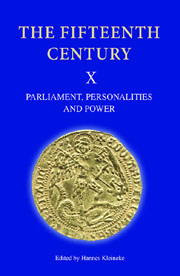Book contents
- Frontmatter
- Contents
- List of Illustrations
- Contributors
- Acknowledgements
- Preface
- Abbreviations
- The People and Parliament in Fifteenth-Century England
- ‘A Beest envenymed thorough … covetize’: an Imposter Pilgrim and the Disputed Descent of the Manor of Dodford, 1306-1481
- Henry Inglose: A Hard Man to Please
- London Merchants and the Borromei Bank in the 1430s: the Role of Local Credit Networks
- ‘Mischieviously Slewen’: John, Lord Scrope, the Dukes of Norfolk and Suffolk, and the Murder of Henry Howard in 1446
- A Fifteenth-Century Medicus Politicus: John Somerset, Physician to Henry VI
- ‘Domine Salvum Fac Regem’: The Origin of ‘God Save the King’ in the Reign of Henry VI
- ‘Monuments of Honour’: Clerks, Histories and Heroes in the London Livery Companies
- The East Anglian Parliamentary Elections of 1461
- Changing Perceptions of the Soldier in Late Medieval England
- Thomas More, the London Charterhouse and Richard III
- Index
- Tabula Gratulatoria
Thomas More, the London Charterhouse and Richard III
Published online by Cambridge University Press: 05 February 2013
- Frontmatter
- Contents
- List of Illustrations
- Contributors
- Acknowledgements
- Preface
- Abbreviations
- The People and Parliament in Fifteenth-Century England
- ‘A Beest envenymed thorough … covetize’: an Imposter Pilgrim and the Disputed Descent of the Manor of Dodford, 1306-1481
- Henry Inglose: A Hard Man to Please
- London Merchants and the Borromei Bank in the 1430s: the Role of Local Credit Networks
- ‘Mischieviously Slewen’: John, Lord Scrope, the Dukes of Norfolk and Suffolk, and the Murder of Henry Howard in 1446
- A Fifteenth-Century Medicus Politicus: John Somerset, Physician to Henry VI
- ‘Domine Salvum Fac Regem’: The Origin of ‘God Save the King’ in the Reign of Henry VI
- ‘Monuments of Honour’: Clerks, Histories and Heroes in the London Livery Companies
- The East Anglian Parliamentary Elections of 1461
- Changing Perceptions of the Soldier in Late Medieval England
- Thomas More, the London Charterhouse and Richard III
- Index
- Tabula Gratulatoria
Summary
The summer of 1535 saw the first high-profile martyrs executed for the Catholic cause in England. In March 1534 Parliament had passed the Act of Succession which recognised the validity of the king's marriage (in January 1533) to Anne Boleyn, and this was followed in November that year by the Act of Supremacy which acknowledged the king as supreme head on earth of the Church of England. Subjects were required to take oaths accepting both acts, or to suffer the penalties for treason. Thomas More, seeing the way the wind was blowing, had resigned the chancellorship in May 1532; in April 1534 he had refused to swear to the Act of Succession and was sent to the Tower, where he busied himself writing treatises on the sufferings of Christ. He likewise refused to swear to the Act of Supremacy later that year.
The monks of the London Charterhouse, led by Prior John Houghton, were also facing demands that they should swear to accept both acts. At first they resisted, but then, in May 1534, led by Houghton, they reluctantly accepted the Act of Succession. But this did not save them from further pressure to conform. Houghton was visited by two other Carthusian priors, Robert Laurence from Beauvale and Augustine Webster from Axholme. The three men were arrested on 20 April 1535, together with Dr. Richard Reynolds, a brother from Syon, and taken to the Tower. On 28 April the men were tried: they refused the oath and argued that obedience to the pope was necessary to preserve the spiritual unity of the mystical body of Christ.
- Type
- Chapter
- Information
- The Fifteenth Century XParliament, Personalities and Power - Papers Presented to Linda S. Clark, pp. 203 - 214Publisher: Boydell & BrewerPrint publication year: 2011



